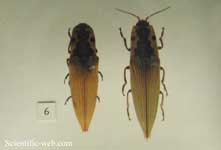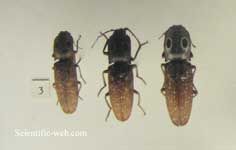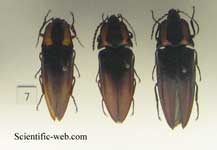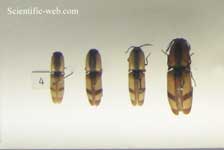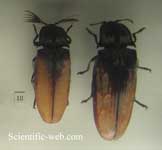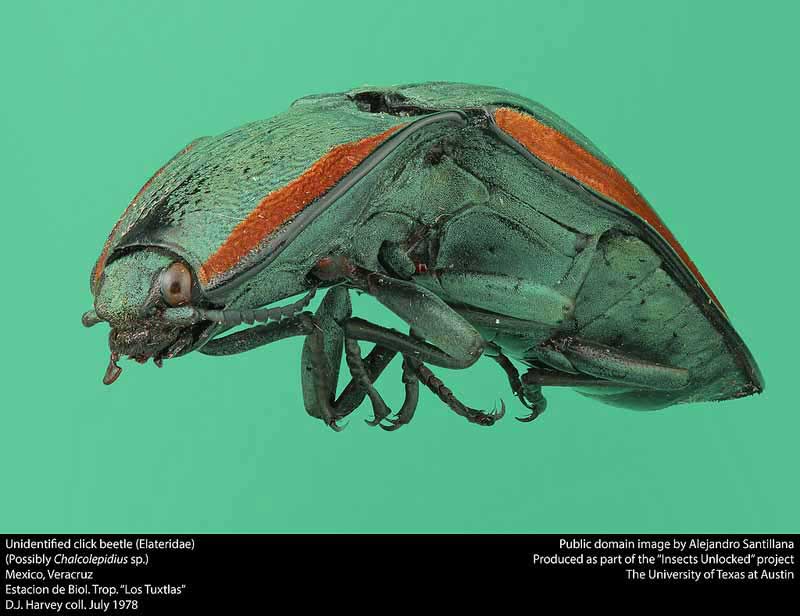
Superregnum: Eukaryota
Cladus: Unikonta
Cladus: Opisthokonta
Cladus: Holozoa
Regnum: Animalia
Subregnum: Eumetazoa
Cladus: Bilateria
Cladus: Nephrozoa
Cladus: Protostomia
Cladus: Ecdysozoa
Cladus: Panarthropoda
Phylum: Arthropoda
Subphylum: Hexapoda
Classis: Insecta
Cladus: Dicondylia
Subclassis: Pterygota
Cladus: Metapterygota
Infraclassis: Neoptera
Cladus: Eumetabola
Cladus: Endopterygota
Superordo: Coleopterida
Ordo: Coleoptera
Subordo: Polyphaga
Infraordo: Elateriformia
Superfamilia: Elateroidea
Familia: Elateridae
Subfamiliae (18 + 1†): Agrypninae – Campyloxeninae – Cardiophorinae – Cebrioninae – Dendrometrinae – Elaterinae – Eudicronychinae – Hemiopinae – Lissominae – Morostomatinae – Negastriinae – Oxynopterinae – Physodactylinae – Pityobiinae – Plastocerinae – †Protagrypninae – Semiotinae – Sinopyrophorinae – Subprotelaterinae – Tetralobinae – Thylacosterninae
Source(s) of checklist:
Checklist based uncritically on Bouchard et al., 2011
Overview of genera
Campylomorphus – Dacnitus – †Cardiosyne – Neoabiphis – Neolycoreus – Paulusiella – Plectrosternus – Limoniscus – ... Sinopyrophorus
Name
Elateridae Leach, 1815
Synonyms
Cebrionidae
Plastoceridae
References
Leach, W.E. 1815. Entomology [pp. 57–172]. In: Brewster, D. (Ed). Brewster’s Edinburgh Encyclopedia. Volume IX [part I]. W. Blackwood, J. Waugh, etc., Edinburgh, 764 pp. BHL Reference page.
Bi, W-X., He, J-W., Chen, C-C., Kundrata, R. & Li, X-Y. 2019. Sinopyrophorinae, a new subfamily of Elateridae (Coleoptera, Elateroidea) with the first record of a luminous click beetle in Asia and evidence for multiple origins of bioluminescence in Elateridae.ZooKeys, 864: 79–97. DOI: 10.3897/zookeys.864.26689. Reference page.
Bouchard, P., Bousquet, Y., Davies, A.E., Alonso-Zarazaga, M.A., Lawrence, J.F., Lyal, C.H.C., Newton, A.F., Reid, C.A.M., Schmitt, M., Ślipiński, S.A. & Smith, A.B.T. 2011. Family-group names in Coleoptera (Insecta). ZooKeys 88: 1–972. DOI: 10.3897/zookeys.88.807 Open access. PMC: 3088472 Open access. Reference page.
Costa, C., Lawrence, J.F. & Policena Rosa, S. 2010. 4.7. Elateridae Leach, 1815. Pp. 75–103 in: Leschen, R.A.B., Beutel, R.G. & Lawrence, J.F. (volume eds.) Coleoptera, beetles. Volume 2: Morphology and systematics (Elateroidea, Bostrichiformia, Cucujiformia partim). In: Kristensen, N.P. & Beutel, R.G. (eds.) Handbook of zoology. A natural history of the phyla of the animal kingdom. Volume IV. Arthropoda: Insecta. Part 38. Berlin, New York: Walter de Gruyter. ISBN 3-11-019075-3, ISBN 978-3-11-019075-5
Douglas, H. 2011. Phylogenetic relationships of Elateridae inferred from adult morphology, with special reference to the position of Cardiophorinae. Zootaxa 2900: 1–45. Preview (PDF)
Kundrata, R. & Bocak, L. 2011. The phylogeny and limits of Elateridae (Insecta, Coleoptera): is there a common tendency of click beetles to soft-bodiedness and neoteny? Zoologica scripta 40(4): 364–378. DOI: 10.1111/j.1463-6409.2011.00476.x Reference page.
Kundrata, R., Kubaczkova, M., Prosvirov, A.S., Douglas, H.B., Fojtikova, A., Costa, C., Bosquet, Y., Alonso-Zarazaga, M.A. & Bouchard, P. 2019. World catalogue of the genus-group names in Elateridae (Insecta, Coleoptera). Part I: Agrypninae, Campyloxeninae, Hemiopinae, Lissominae, Oestodinae, Parablacinae, Physodactylinae, Pityobiinae, Subprotelaterinae, Tetralobinae. ZooKeys 839: 83–154. DOI: 10.3897/zookeys.839.33279 Open access. Reference page.
Lawrence, J.F., Beutel, R.G., Leschen, R.A.B. & Ślipiński, A. 2010. 1. Changes in classification and list of families and subfamilies. Pp. 1–7 in: Leschen, R.A.B., Beutel, R.G. & Lawrence, J.F. (volume eds.) Coleoptera, beetles. Volume 2: Morphology and systematics (Elateroidea, Bostrichiformia, Cucujiformia partim). In: Kristensen, N.P. & Beutel, R.G. (eds.) Handbook of zoology. A natural history of the phyla of the animal kingdom. Volume IV. Arthropoda: Insecta. Part 38. Berlin, New York: Walter de Gruyter. ISBN 3-11-019075-3, ISBN 978-3-11-019075-5
Additional references
Calder, A.A. 1996. Click beetles: genera of the Australian Elateridae (Coleoptera). Monographs on invertebrate taxonomy 2. ISBN 0-643-05671-8, ISBN 978-0-643-05671-8
Neboiss, A. 1956. A check list of Australian Elateridae (Coleoptera). Memoirs of the National Museum of Victoria (22)(2).
Hyslop, J.A. 1921. Genotypes of the elaterid beetles of the world. Proceedings of the United States National Museum 58: 621–673. Internet Archive. BHL. BUGZ.
Ivie, M.A. & Barclay, M.V.L. 2011. The familial placement and specific membership of Escalerina Bolívar y Pieltain and Paulusiella Löbl (Coleoptera: Elateridae, Dascillidae, Drilidae), with new synonymies. Coleopterists bulletin 65(2): 167–172. DOI: 10.1649/072.065.0216
Johnson, P.J. 2002. in American Beetles, CRC Press.
Kubaczkova, M. & Kundrata, R. 2017. Annotated catalogue of the click-beetle subfamily Tetralobinae (Coleoptera: Elateridae). Zootaxa 4323(2): 151–184. DOI: 10.11646/zootaxa.4323.2.1. Reference page.
I.Löbl & A.Smetana (eds). 2007. Catalogue of Palearctic Coleoptera. Vol. 4: Elateroidea, Derodontoidea, Bostrichoidea, Lymexyloidea, Cleroidea and Cucujoidea p. 89. [PDF. Apollo Books, Stenstrup, Denmark. ISBN 87-88757-67-6, ISBN 978-87-88757-67-5
Németh, T. & Platia, G. 2014. On some Palaearctic click beetles deposited in the Hungarian Natural History Museum, 2 (Coleoptera: Elateridae). Zootaxa 3841(4): 451–490. DOI: 10.11646/zootaxa.3841.4.1 Reference page.
Platia, G. & Ghahari, H. 2016. An annotated checklist of click-beetles (Coleoptera, Elateridae) from Iran. Zootaxa 4137(2): 239–275. DOI: 10.11646/zootaxa.4137.2.6. Reference page.
Stibick, J.N.F. 1979. Classification of the Elateridae (Coleoptera). Relationships and classification of the subfamilies and tribes. Pacific insects 20: 145–186. PDF
Links
Australian Faunal Directory
Cebrionidae in SYNOPSIS OF THE DESCRIBED COLEOPTERA OF THE WORLD
Elateridae in SYNOPSIS OF THE DESCRIBED COLEOPTERA OF THE WORLD
Classification of Costa Rican Elateridae
Atlas of click beetles (Elateridae) of Russia
ELATERIDAE Click beetles of Palearctic Region (c) V. Dušánek & J. Mertlik
Taxonomical list of the genera of click beetles (Elateridae) of Russia and adjacent countries
Josef Mertlik Taxonomical list of the genera of click beetles (Elateridae) of Russia and adjacent countries
Vernacular names
беларуская: Шчаўкуны
čeština: Kovaříkovití
dansk: Smældere
Deutsch: Schnellkäfer
English: Click Beetle
suomi: Sepät
Nordfriisk: Knekern
français: Taupin
日本語: コメツキムシ科
lietuvių: Sprakšiai
македонски: Скочибуби
Nederlands: Kniptorren
norsk: Smellere
polski: Sprężykowate
русский: Щелкуны
中文: 叩頭蟲科
Elateridae or click beetles (or "typical click beetles" to distinguish them from the related families Cerophytidae and Eucnemidae) are a family of beetles. Other names include elaters, snapping beetles, spring beetles or skipjacks. This family was defined by William Elford Leach (1790–1836) in 1815. They are a cosmopolitan beetle family characterized by the unusual click mechanism they possess. There are a few other families of Elateroidea in which a few members have the same mechanism, but most elaterid subfamilies can click. A spine on the prosternum can be snapped into a corresponding notch on the mesosternum, producing a violent "click" that can bounce the beetle into the air.[3] Clicking is mainly used to avoid predation, although it is also useful when the beetle is on its back and needs to right itself. There are about 9300 known species worldwide,[4] and 965 valid species in North America.[5]
Etymology
Leach took the family name from the genus Elater, coined by Linnaeus in 1758. In Greek, ἐλατήρ means one who drives, pushes, or beats out.[6] It is also the origin of the word "elastic", from the notion of beating out a ductile substance.[7]
Description and ecology
Some click beetles are large and colorful, but most are under two centimeters long and brown or black, without markings. The adults are typically nocturnal and phytophagous, but only some are of economic importance. On hot nights they may enter houses, but are not pests there. Click beetle larvae, called wireworms, are usually saprophagous, living on dead organisms, but some species are serious agricultural pests, and others are active predators of other insect larvae. Some elaterid species are bioluminescent in both larval and adult form, such as those of the genus Pyrophorus.
Larvae are elongate, cylindrical or somewhat flattened, with hard bodies, somewhat resembling mealworms. The three pairs of legs on the thoracic segments are short and the last abdominal segment is, as is frequently the case in beetle larvae, directed downward and may serve as a terminal proleg in some species.[8] The ninth segment, the rearmost, is pointed in larvae of Agriotes, Dalopius and Melanotus, but is bifid due to a so-called caudal notch in Selatosomus (formerly Ctenicera), Limonius, Hypnoides and Athous species.[9] The dorsum of the ninth abdominal segment may also have sharp processes, such as in the Oestodini, including the genera Drapetes and Oestodes. Although some species complete their development in one year (e.g. Conoderus), most wireworms spend three or four years in the soil, feeding on decaying vegetation and the roots of plants, and often causing damage to agricultural crops such as potato, strawberry, corn, and wheat.[10][11] The subterranean habits of wireworms, their ability to quickly locate food by following carbon dioxide gradients produced by plant material in the soil,[12] and their remarkable ability to recover from illness induced by insecticide exposure (sometimes after many months),[13] make it hard to exterminate them once they have begun to attack a crop. Wireworms can pass easily through the soil on account of their shape and their propensity for following pre-existing burrows,[14] and can travel from plant to plant, thus injuring the roots of multiple plants within a short time. Methods for pest control include crop rotation and clearing the land of insects before sowing.
Other subterranean creatures such as the leatherjacket grub of crane flies which have no legs, and geophilid centipedes, which may have over two hundred, are sometimes confused with the six-legged wireworms.[8]
Evolution
The oldest known species date to the Triassic, but most are problematic due to only being known from isolated elytra. Many fossil elaterids belong to the extinct subfamily Protagrypninae.[15]
Selected genera
Actenicerus
Adelocera
Adrastus
Aeoloderma
Aeoloides
Aeolus
Agriotes
Agrypnus
Alaus
Ampedus
Anchastus
Anostirus
Aplotarsus
Athous
Balgus
Betarmon
Brachygonus
Brachylacon
Brongniartia
Calambus
Cardiophorus
Cebrio
Chalcolepidus
Cidnopus
Conoderus
Craspedostethus
Crepidophorus
Ctenicera
Dacnitus
Dalopius
Danosoma
Deilelater
Diacanthous
Dicronychus
Dima
Drilus
Eanus
Ectamenogonus
Ectinus
Elater
Elathous
Eopenthes
Fleutiauxellus
Haterumelater
Hemicleus
Hemicrepidius
Heteroderes
Horistonotus
Hypnoidus
Hypoganus
Hypolithus
Idolus
Ignelater
Ischnodes
Isidus
Itodacne
Jonthadocerus
Lacon
Lanelater
Limoniscus
Limonius
Liotrichus
Megapenthes
Melanotus
Melanoxanthus
Metanomus
Merklelater
Mulsanteus
Negastrius
Neopristilophus
Nothodes
Oedostethus
Orithales
Paracardiophorus
Paraphotistus
Peripontius
Pheletes
Pittonotus
Pityobius
Podeonius
Porthmidius
Procraerus
Prodrasterius
Prosternon
Pyrearinus
Pyrophorus
Quasimus
Reitterelater
Selatosomus
Sericus
Simodactylus
Spheniscosomus
Stenagostus
Synaptus
Vesperelater
Zorochros
Notes
Lateral aspect of a typical member of the Elateridae. Just below the base of the wings the "clicking" apparatus is visible in silhouette, with the "peg" or "process" in contact with the raised slot or "cavity" into which it slips to force the impact when required.
Kusy, Dominik; Motyka, Michal; Bocek, Matej; Vogler, Alfried P.; Bocak, Ladislav (2018-11-20). "Genome sequences identify three families of Coleoptera as morphologically derived click beetles (Elateridae)". Scientific Reports. Springer Science and Business Media LLC. 8 (1): 17084. Bibcode:2018NatSR...817084K. doi:10.1038/s41598-018-35328-0. ISSN 2045-2322. PMC 6244081. PMID 30459416.
Robin Kundrata, Nicole L. Gunter, Dominika Janosikova & Ladislav Bocak (2018) Molecular evidence for the subfamilial status of Tetralobinae (Coleoptera: Elateridae), with comments on parallel evolution of some phenotypic characters. Arthropod Systematics & Phylogeny 76: 137-145.
How the click beetle jumps from the back !. Myrmecofourmis.fr on Youtube. 2015. Archived from the original on 2021-12-21. Retrieved 3 December 2015.
Schneider, M. C.; et al. (2006). "Evolutionary chromosomal differentiation among four species of Conoderus Eschscholtz, 1829 (Coleoptera, Elateridae, Agrypninae, Conoderini) detected by standard staining, C-banding, silver nitrate impregnation, and CMA3/DA/DAPI staining". Genetica. 128 (1–3): 333–346. doi:10.1007/s10709-006-7101-5. PMID 17028962. S2CID 1901849.
Majka, C. G.; P. J. Johnson (2008). "The Elateridae (Coleoptera) of the Maritime Provinces of Canada: faunal composition, new records, and taxonomic changes" (PDF excerpt). Zootaxa. 1811: 1–33. doi:10.11646/zootaxa.1811.1.1.
Wiktionary - "elater"
Wiktionary - "elastic"
One or more of the preceding sentences incorporates text from a publication now in the public domain: Chisholm, Hugh, ed. (1911). "Wireworm". Encyclopædia Britannica. Vol. 28 (11th ed.). Cambridge University Press. p. 739.
van Herk, W. (March 12, 2009). "Limonius: wireworm research site". Archived from the original on June 7, 2011. Retrieved January 22, 2011.
R. S. Vernon; W. van Herk; J. Tolman; H. Ortiz Saavedra; M. Clodius; B. Gage (2008). "Transitional sublethal and lethal effects of insecticides after dermal exposures to five economic species of wireworms (Coleoptera: Elateridae)". Journal of Economic Entomology. 101 (2): 365–374. doi:10.1603/0022-0493(2008)101[365:TSALEO]2.0.CO;2. PMID 18459400.
William E. Parker; Julia J. Howard (2001). "The biology and management of wireworms (Agriotes spp.) on potato with particular reference to the U.K." Agricultural and Forest Entomology. 3 (2): 85–98. doi:10.1046/j.1461-9563.2001.00094.x.
J. F. Doane; Y. W. Lee; N. D. Westcott; J. Klingler (1975). "The orientation response of Ctenicera destructor and other wireworms (Coleoptera: Elateridae) to germinating grain and to carbon dioxide". Canadian Entomologist. 107 (12): 1233–1252. doi:10.4039/Ent1071233-12.
W. G. van Herk; R. S. Vernon; J. H. Tolman; H. Ortiz Saavedra (2008). "Mortality of a wireworm, Agriotes obscurus (Coleoptera: Elateridae), after topical application of various insecticides". Journal of Economic Entomology. 101 (2): 375–383. doi:10.1603/0022-0493(2008)101[375:moawao]2.0.co;2. PMID 18459401.
Willem G. van Herk; Robert S. Vernon (2007). "Soil bioassay for studying behavioral responses of wireworms (Coleoptera: Elateridae) to inecticide-treated wheat seed". Environmental Entomology. 36 (6): 1441–1449. doi:10.1603/0046-225X(2007)36[1441:SBFSBR]2.0.CO;2. PMID 18284772.
Kundrata, Robin; Packova, Gabriela; Hoffmannova, Johana (2020-06-26). "Fossil Genera in Elateridae (Insecta, Coleoptera): A Triassic Origin and Jurassic Diversification". Insects. 11 (6): 394. doi:10.3390/insects11060394. ISSN 2075-4450. PMC 7348820. PMID 32604761.
References
Rines, George Edwin, ed. (1920). "Click Beetle" . Encyclopedia Americana.
Retrieved from "http://en.wikipedia.org/"
All text is available under the terms of the GNU Free Documentation License

